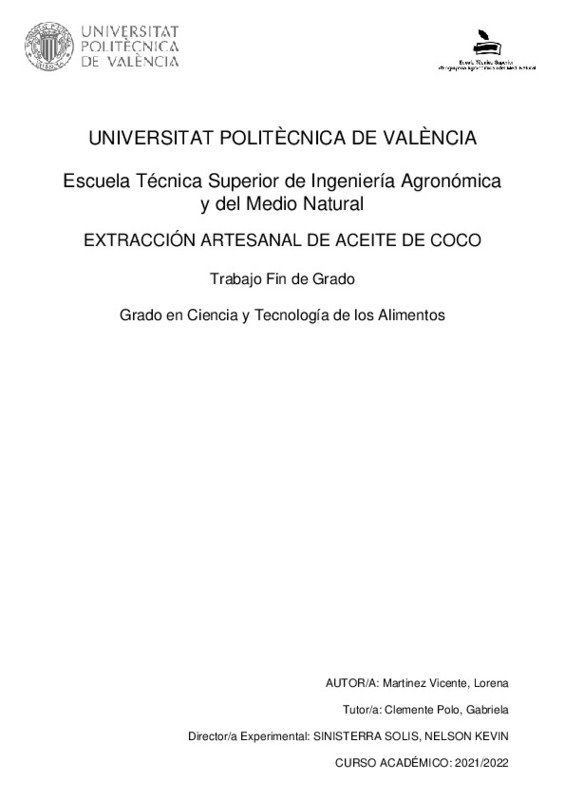|
Resumen:
|
[EN] Coconut (Cocos nucifera L.), given its high fat content, is one of the most used species to produce vegetable oils, and is also a primary source of food. Colombia has a very high production of coconut trees, so the ...[+]
[EN] Coconut (Cocos nucifera L.), given its high fat content, is one of the most used species to produce vegetable oils, and is also a primary source of food. Colombia has a very high production of coconut trees, so the development of products derived from it can represent an economic boost for the country. The objective of this project is to determine the potential uses of coconut oil extracted in an artisanal way. The purpose is to take advantage of the economic potential of coconut, in the Sanquianga subregion, Colombia. The coconut oil was extracted handcrafted, and a series of physicochemical determinations were made, these were the iodine value, the saponification value, the density, the color difference, the peroxide value and the extinction coefficients k270 and k232. The oil extracted in the laboratory was compared with other commercial brand oils, in addition, time and temperature conditions for oil maturation were established, with the aim of analyzing the kinetics of oil oxidation, which leads to its deterioration. The iodine value indicated that the extracted coconut oil has a lower number of unsaturations (double bonds) than sunflower and olive oil, while there were no significant differences between the extracted oil and the oils found on the market. The saponification index was also analyzed, showing that coconut oil has long-chain fatty acids, in addition, it also indicates that coconut oil is a good agent for soap making, due to the amount of saponifiable fraction in its fatty acids. The kinetics of the peroxides and of the specific extinction coefficients k232 and k270, reflected the stability of the oil at temperature, due to its low content of primary oxidation compounds and carbonyl compounds when subjected to high temperatures in a long time As a conclusion, it was deduced that coconut oil, due to its high stability and its different functions, is a suitable product to enhance the economic value of coconut.
[-]
[ES] El coco (Cocos nucifera L.) es un fruto de forma redondeada y alargada con una carne de color blanco (copra), fibrosa y aceitosa cubierta por una cáscara dura, de color marrón y peluda. La copra puede dedicarse a la ...[+]
[ES] El coco (Cocos nucifera L.) es un fruto de forma redondeada y alargada con una carne de color blanco (copra), fibrosa y aceitosa cubierta por una cáscara dura, de color marrón y peluda. La copra puede dedicarse a la obtención de aceite de coco, que posee interesantes propiedades nutricionales, antibacterianas, fungicidas y antioxidantes.
En la subregión Sanquianga (departamento de Nariño, Colombia) el coco es un cultivo con muchas posibilidades. Su situación socio-económica requiere el impulso de actividades agrarias lícitas con un enfoque de sostenibilidad, de manera que se fortalezcan las cadenas productivas tradicionales y se reivindique el papel de las comunidades locales en el país.
El objetivo del presente trabajo es desarrollar un procedimiento de extracción de aceite de coco de forma artesanal, de manera que pueda obtenerse un producto que pueda ser producido y comercializado en la subregión Sanquianga.
[-]
|







